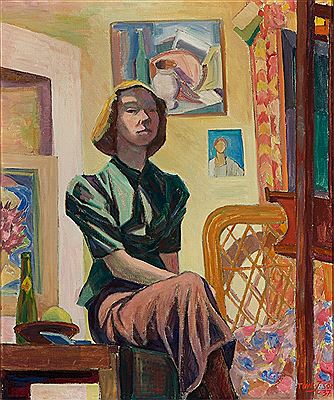Tove Jansson—the Moomins, right? Whimsical and light-hearted freehand drawings, where the characters are captured with only a few simple strokes. This is real talent. But, in fact, Tove Jansson actually thought of herself as a painter and, for almost her entire life, was faced with the question of how to define herself as a painter alongside all these drawings. Can we think of a single painting by Tove Jansson, have we even considered that she may have been a great painter? No, because the Moomins were what prevailed!
I recently read a book about Tove Jansson, written by the Finnish art historian and writer Tuula Karjalainen. A lot has been written about this absolutely unconventional woman, different interpretations aspiring to describe the real and the illusionary world of an artist. Tove Jansson’s colourful life history has certainly provided justified grounds for these discussions. This is someone whose life was rich in personal events and the skilful expression of these deep insights in a manner which entwines the whole world in the end. There probably is no place in the world where the Moomins are not heard of.
The tales of the Moomins featured characters drawn from Tove Jansson’s own life and almost all characters had their prototypes; they were an amalgamation of fantasy, past experiences, emotions and situations. Writing meant shutting oneself off, serving as an escape, a delight, consolation and self-actualisation. The stories of the Moomins started in the 1930s, when Tove escaped to the safety of her imagination to escape the bleakness of the war. When the Moomins were first conceived, the Finnish public was not yet ready to embrace the characters, not understanding whether they were children’s stories or something else.
The books were published in Sweden more actively than in Finland. It was hard to narrow down these unique characters and their stories of the human condition into a defined box, ages 3–6, 7–10 or 12–15, or to read them as timid, black-and-white fairy tales with a clearly defined moral. For whom are good children’s books written? Who is the reader of The Little Prince, Alice in Wonderland, Charlie and the Chocolate Factory or the Moomins?
Today, the Moomins have grown into an entire industry; we continue to identify with the stories and have ceased to question them. There are fewer taboos; everything is possible; we are more open with our children and what is lacking is compensated for by the Internet; the Moomins continue to rule, offering us a smirk in recognition and enjoyment, rather than the desire to recognise these characters as being somewhat unfit for society, as was the case when Tove Jansson was faced with criticism.
One day, however, Tove had enough of the Moomins, because they kept taking over her whole creative realm and overshadowed what the artist herself considered important: painting. Tove Jansson’s brother continued drawing the Moomins as comic strips, and Tove herself tried to find the motivation to continue. Nevertheless, she said her last goodbye to the Moomins at the beginning of the 1970s, when Moominvalley in November was published.
Alongside the whole Moomin saga, Tove Jansson tried to keep banging the same drum, declaring that she was not simply an illustrator – albeit a talented one, and not simply a writer, albeit one that is exceptionally creative and socially sensitive – but instead a painter. The fact that the sound of this drum did not carry particularly far caused her deep and personal grief. Still, a respectable legacy of her works as a painter remains. Throughout her life, Tove Jansson held several solo exhibitions and participated in group exhibitions with her paintings. Her style as a painter was influenced by the global trends of the early 20th century, which reached forward into the 1930s and 1940s. In 1947, she created large murals inside the Helsinki City Government building.
There is little purely realistic subject matter within Tove Jansson’s paintings; even here she gravitated towards the whimsical, citing paradise and letting her imagination fly. Her realistic work depicting her family was dubbed too rational and received criticism, while her fantasy landscapes were its complete opposite. As a painter, she was searching for herself in everything, in the compositions, lighting, motifs, painting styles as well as techniques, while we got the impression that she was searching for herself only within the Moomins...
Looking behind a name can often bring unexpected discoveries. The pictures and names we tend to equate with one another may end up being a completely different equation. Creative work is like a giant shield, behind which their creators quietly hide, being completely different from who we expect them to be... eternal and permanent contradictions between who we seem to be and who we actually are or who we want to be.
.png)
